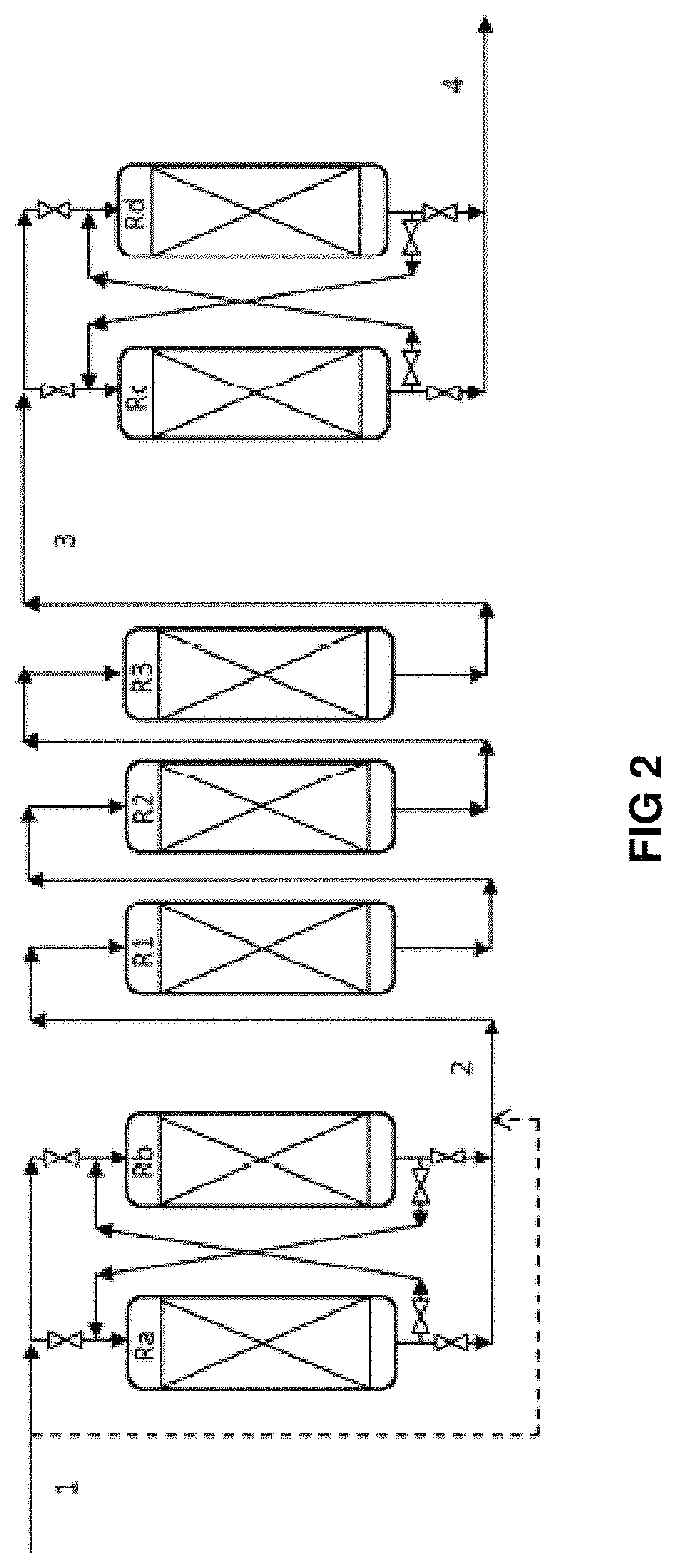Conversion process comprising permutable hydrodemetallization guard beds, a fixed-bed hydrotreatment step and a hydrocracking step in permutable reactors
a technology of permutable hydrodemetallization and guard beds, which is applied in the direction of hydrocarbon oil cracking, lead carbonates, refining to eliminate heteroatoms, etc., and can solve problems such as problems such as quality problems
- Summary
- Abstract
- Description
- Claims
- Application Information
AI Technical Summary
Benefits of technology
Problems solved by technology
Method used
Image
Examples
example 1 (
Not According to the Invention)
[0125]The feedstock is a mixture of atmospheric residues (AR) of Middle East origin. This mixture is characterized by a high quantity of metals (100 ppm by weight) and sulphur (4.0% by weight), as well as 7% of [370-].
[0126]The hydrotreatment process comprises the use of two permutable reactors Ra and Rb in the first stage of hydrodemetallization (HDM) upstream of a fixed-bed hydrotreatment section.
[0127]During the first so-called hydrodemetallization stage, the feedstock of hydrocarbons and hydrogen is passed over an HDM catalyst under HDM conditions, then during the subsequent second stage, the effluent from the first stage is passed over an HDT catalyst under HDT conditions. The HDM stage comprises an HDM zone with permutable beds (Ra, Rb). The HDT hydrotreatment stage comprises three fixed-bed reactors (R1, R2, R3).
[0128]The effluent obtained at the end of hydrotreatment stage is separated by flash in order to obtain a liquid fraction and a gaseous...
example 2 (
According to the Invention)
[0136]The process according to the invention is operated in this example with the same feedstock, the same catalysts, and under the same operating conditions for the reactors of the hydrodemetallization stage and the reactors R1 and R2 of the hydrotreatment (HDT) stage b).
[0137]The process according to the invention comprises the use of two new hydrocracking permutable reactors denoted Rc and Rd, replacing a part of the reactor R3 that appears in the hydrotreatment (HDT) section of the prior art. Hydrocracking stage c) is carried out at high temperature downstream of fixed-bed hydrotreatment stage b) which comprises only two reactors R1 and R2.
[0138]Table 2 below gives an example of operation around the 4 permutable reactors Ra, Rb, Rc and Rd.
[0139]
TABLE 2Operations around the permutable reactors according to the inventionCycle stage (HDM Cycle stage (HCK permutable reactors)permutable reactors)InterventionaRa + Rba′Rc + Rd—bRbRc + RdRacRa + RbRc + Rd—Ra +...
PUM
| Property | Measurement | Unit |
|---|---|---|
| boiling temperature | aaaaa | aaaaa |
| boiling temperature | aaaaa | aaaaa |
| pressure | aaaaa | aaaaa |
Abstract
Description
Claims
Application Information
 Login to View More
Login to View More - R&D
- Intellectual Property
- Life Sciences
- Materials
- Tech Scout
- Unparalleled Data Quality
- Higher Quality Content
- 60% Fewer Hallucinations
Browse by: Latest US Patents, China's latest patents, Technical Efficacy Thesaurus, Application Domain, Technology Topic, Popular Technical Reports.
© 2025 PatSnap. All rights reserved.Legal|Privacy policy|Modern Slavery Act Transparency Statement|Sitemap|About US| Contact US: help@patsnap.com


